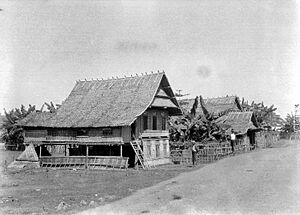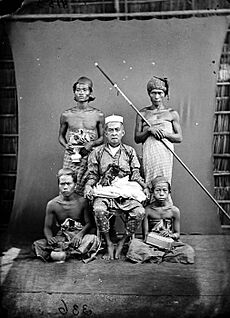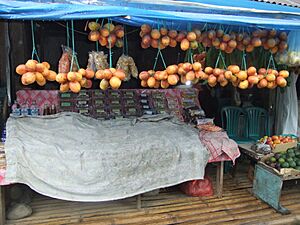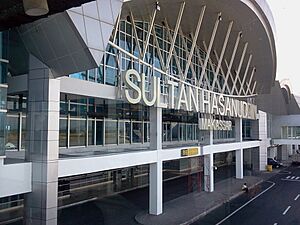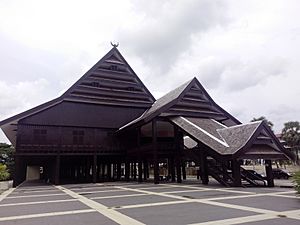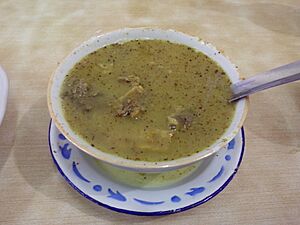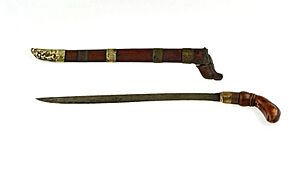South Sulawesi facts for kids
Quick facts for kids
South Sulawesi
Sulawesi Selatan
|
||
|---|---|---|
| Province of South Sulawesi | ||
|
||
| Motto(s):
Toddopuli (Bugis-Makassar)
ᨈᨚᨉᨚᨄᨘᨒᨗ "Keep the faith" |
||
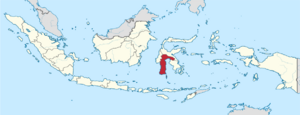
Location of South Sulawesi in Indonesia
|
||
|
OpenStreetMap
|
||
| Founded | 13 December 1960 | |
| Capital and largest city |
Makassar | |
| Government | ||
| • Body | South Sulawesi Provincial Government | |
| Area | ||
| • Total | 45,330.55 km2 (17,502.22 sq mi) | |
| Area rank | 16th | |
| Highest elevation
(Mount Latimojong)
|
3,478 m (11,411 ft) | |
| Population
(mid 2023 Estimate)
|
||
| • Total | 9,362,290 | |
| • Density | 206.53378/km2 (534.9200/sq mi) | |
| Demographics | ||
| • Ethnic groups | 45.12% Buginese 29.68% Makassarese 7.34% Torajan 4.93% Luwu 2.86% Javanese 2.8% Duri 6.3% other |
|
| • Religion | 89.78% Islam 7.64% Protestantism 1.55% Catholicism 0.73% Hinduism 0.25% Buddhism 0.06% Confucianism and other |
|
| • Languages | Indonesian (official) Makassar Malay (lingua franca, casual) Buginese, Makassarese, Luwu, Toraja (regional) |
|
| Time zone | UTC+08 (Indonesia Central Time) | |
| ISO 3166 code | ID-SN | |
| GDP (nominal) | 2022 | |
| - Total | Rp 605.2 trillion (9th) US$ 40.8 billion Int$ 124.3 billion (PPP) |
|
| - Per capita | Rp 65.6 million (12th) US$ 4,417 Int$ 13,784 (PPP) |
|
| - Growth | ||
| HDI | ||
South Sulawesi (Indonesian: Sulawesi Selatan) is a province in Indonesia. It is located on the southern part of the island of Sulawesi. The Selayar Islands are also part of this province. Its capital and largest city is Makassar.
South Sulawesi is bordered by Central Sulawesi and West Sulawesi to the north. To the east are the Gulf of Bone and Southeast Sulawesi. The Makassar Strait is to the west, and the Flores Sea is to the south.
In mid-2023, about 9.36 million people lived here. This makes South Sulawesi the most populated province on Sulawesi island. The main groups of people living here are the Buginese, Makassarese, and Toraja. The economy relies on farming, fishing, and mining for gold and other metals. The pinisi, a traditional Indonesian sailing ship, is still used by the Buginese and Makassarese people. They use it for moving goods between islands, for cargo, and for fishing.
During the spice trade from the 1400s to 1800s, South Sulawesi was a key entry point to the Maluku Islands. There were several small kingdoms, like the Sultanate of Gowa and the Bugis kingdom in Bone. The Dutch East India Company (VOC) arrived in the 1600s. They teamed up with a Bugis prince, Arung Palakka, to defeat the Gowa kingdom. The king of Gowa, Sultan Hasanuddin, had to sign a treaty that reduced Gowa's power.
Contents
History of South Sulawesi
People first lived in Sulawesi about 30,000 years ago. Scientists found old tools and bones near Maros, close to Makassar. Ancient handprint paintings, about 35,000 to 40,000 years old, were found in the Pettakere cave.
In the early 1300s, trade grew because more people wanted rice from South Sulawesi. This led to more farming and stronger kingdoms. Farmers started growing more wet rice instead of using slash-and-burn methods. This caused the population to grow. New towns appeared as forests were cleared.
New farming kingdoms like Boné and Wajoq (Bugis) and Gowa (Makassar) became powerful. By the early 1500s, Boné was strong in the east, and Gowa and Talloq were strong in the west. They fought each other for control.
In 1582, Boné, Soppéng, and Wajoq formed an alliance called the Tellumpocco. They wanted to stop Gowa from expanding and to keep their freedom. Gowa tried to attack them several times but failed. However, by the early 1600s, Gowa and Talloq became the main powers. They supported international trade and adopted Islam. Gowa defeated the Bugis kingdoms between 1609 and 1611.
The Dutch East India Company (VOC) arrived in the 1600s. They saw the Kingdom of Gowa as a problem for their spice trade. The VOC joined forces with Arung Palakka, a Bugis prince. After a year of fighting, they defeated Gowa. Sultan Hasanuddin, the king of Gowa, was forced to sign a treaty that greatly reduced Gowa's power. Palakka then became the ruler of South Sulawesi.
Later, a Bugis queen led a fight against the Dutch. The Dutch were busy with wars in Europe. After those wars ended, the Dutch returned and stopped the queen's rebellion. However, the Bugis people continued to resist Dutch rule until 1905. In 1905, the Dutch also took control of Tana Toraja.

Before Indonesia became independent, South Sulawesi had many small kingdoms. Four main ethnic groups lived there: the Bugis, Makassar, Mandar, and Toraja.
On June 16, 2022, a tornado hit the province. It damaged 63 homes.
Geography
South Sulawesi is located at 4°20'S 120°15'E. It covers an area of about 45,330 square kilometers.
Government and Divisions
After Indonesia became independent, the government created the Sulawesi province in 1950. In 1960, it became the South/Southeast Sulawesi province. Then, in 1964, South Sulawesi and Southeast Sulawesi became separate provinces. In 2004, parts of South Sulawesi became a new province called West Sulawesi.
The remaining South Sulawesi Province is divided into 21 regencies and three independent cities. These areas elect members to the People's Representative Council.
People of South Sulawesi
Ethnic Groups
Ethnicities of South Sulawesi - 2010 Census Buginese (41.9%) Makassarese (25.43%) Toraja (9.02%) Mandarese (6.1%) Javanese (3.0%) Chinese (1.4%) Others (13.15%)
| Historical population | ||
|---|---|---|
| Year | Pop. | ±% |
| 1971 | 5,180,576 | — |
| 1980 | 6,062,212 | +17.0% |
| 1990 | 6,981,646 | +15.2% |
| 1995 | 7,558,368 | +8.3% |
| 2000 | 7,159,170 | −5.3% |
| 2010 | 8,034,776 | +12.2% |
| 2020 | 9,073,509 | +12.9% |
| 2023 | 9,362,290 | +3.2% |
| Source: Badan Pusat Statistik 2011, 2021 to 2024. The reduction between 1995 and 2000 is due to the separation of West Sulawesi from South Sulawesi. | ||
Religion in South Sulawesi (2022) Islam (89.88%) Protestantism (7.41%) Roman Catholic (1.62%) Hinduism (0.68%) Buddhism (0.22%) Confucianism (0.003%)
South Sulawesi has many different ethnic groups. The three main ones are:
- The Buginese (Suku Bugis) are the largest group, with almost 4 million people. They live in the middle of the southern part of South Sulawesi. Many have moved to other islands, even as far as Malaysia.
- The Makassarese (Suku Makassar) are the second largest group. They speak the Makassar language. They live in the southern part of the province, including Makassar city. There are over 2 million Makassarese people.
- The Torajan (Suku Toraja) are native to the mountainous northern region. This area includes Tana Toraja and North Toraja Regencies.
Languages Spoken
Many languages and dialects are spoken in South Sulawesi. Most of them belong to the Malayo-Polynesian family. Here are some of the main languages:
- Makassarese is spoken in the southwest, including Makassar. About 2.1 million people speak it.
- Buginese is spoken across a large area from Pinrang to Bulukumba. It is the most common language in many communities. Around 5 million people speak it as their first language.
- The Tae' language is mostly spoken in Tana Luwu, in the northeast. About 400,000 people spoke it in 2020.
- The Toraja language is the native language of Tana Toraja. Over 800,000 people speak it.
- Mandar, Mamuju, and Pattae' are spoken by the Mandar people. They live in West Sulawesi and coastal parts of South Sulawesi. About 400,000 people speak these languages.
- The Duri language is spoken north of Mount Bambapuang in Enrekang. Around 130,000 people are native speakers.
- The Konjo language has two groups: Coastal Konjo and Highland Konjo. Coastal Konjo live near the coast in Bulukumba. Mountain Konjo live in the mountains around Bawakaraeng. Almost 300,000 people speak Konjo.
Religion
The main religion in South Sulawesi is Islam, followed by about 89.62% of the people. Other major religions include Protestantism, Roman Catholicism, Buddhism, and Hinduism.
Economy
South Sulawesi GDP share by sector (2022) Agriculture (22.10%) Manufacturing (12.90%) Other Industrial (19.27%) Service (45.73%)
The economy of South Sulawesi grew by 7.78% in 2008 and 6.20% in 2009. In early 2010, it grew by 7.77%.
Natural Resources
South Sulawesi is a major rice producer for Indonesia. It produces over 2.3 million tons of rice each year. A large amount of this rice is sent to other eastern areas of Indonesia. Rice is even exported to Malaysia, the Philippines, and Papua New Guinea. The biggest rice farms are in Bone, Soppeng, Wajo, Sidrap, Pinrang, and Luwu.
Food Production
Besides rice, South Sulawesi also grows corn, cassava, sweet potatoes, green beans, peanuts, and soybeans. Luxury crops like cocoa, coffee, pepper, vanilla, and cashews are also grown.
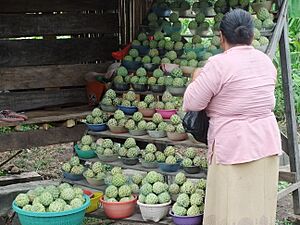
Fishing is also important. Tuna and snapper-grouper are caught in large amounts. Seaweed is also grown for food. Farms raise chickens, cows, pigs, and goats.
Mining
Mining is a big part of South Sulawesi's economy. Nickel, gold, magnesium, iron, granite, and lead are some of the minerals mined here.
Transportation
The Trans-Sulawesi Railway is being built to connect Makassar and Parepare. Parts of the railway are already operating. The full 150 km railway is expected to be finished soon.
Airports in South Sulawesi include:
- Sultan Hasanuddin International Airport (Makassar)
- Palopo Lagaligo Airport (Palopo)
- Pongtiku Airport (Tana Toraja)
- Haji Aroepala Airport (Selayar)
- Andi Jemma Airport (Masamba)
- Soroako Airport (Soroako)
Major ports include:
- Soekarno-Hatta (Makassar)
- Tanjung Ringgit (Palopo)
- Nusantara (Pare-Pare)
- Pattumbukang (Selayar)
Culture
Philosophy
- Siriʼ Na Pacce (ᨔᨗᨑᨗ ᨊ ᨄᨌᨙ) is a key cultural idea for the Bugis-Makassar people. It means keeping your honor and having a strong sense of community. If someone doesn't have siri' na pacce, they are seen as lacking shame or self-respect. This philosophy guides how people act and helps them protect their honor.
- Siriʼ Nipakasiriʼ (ᨔᨗᨑᨗ ᨊᨗᨄᨀᨔᨗᨑᨗ) happens when someone is insulted or treated unfairly. The person or their family must then defend their siri to get their honor back. If they don't, they are called "mate siri'" (ᨆᨈᨙ ᨔᨗᨑᨗ), meaning they have lost their dignity. Bugis-Makassar people would rather die than live without siri.
- Siriʼ Masiriʼ (ᨔᨗᨑᨗ ᨆᨔᨗᨑᨗ) is a way of life focused on working hard to maintain or achieve success and honor.
Traditional Clothing
Baju Bodo (ᨅᨍᨘ ᨅᨚᨉᨚ)[Mks] or Waju Tokko (ᨓᨍᨘ ᨈᨚᨀᨚ)[Bug] is the traditional dress for women. It is a rectangular, short-sleeved blouse. The color of the Baju Bodo used to show the age or status of the woman wearing it. It is often worn for special events like weddings. Today, it is also used for dance performances or to welcome guests.
Traditional Dances
Traditional dances in South Sulawesi combine movements, music, lighting, and costumes. They often tell stories about the community's past, like tales of war or celebrations.
The Bugis-Makassar tribes have many dance styles. The Toraja people also have traditional dances, often used in rituals. Other tribes like the Mandar, Duri, and Ammatoa Kajang also contribute to the unique art of South Sulawesi.
Traditional Ship
The pinisiʼ or phinisi (ᨄᨗᨊᨗᨔᨗ) is a traditional Indonesian two-masted sailing ship. It was mainly built by the Konjo tribe. However, the Buginese and Makassarese people widely use it. They use it for moving goods between islands, for cargo, and for fishing in Indonesia.
These ships can be 20 to 35 meters long and weigh up to 350 tons. Their masts can be as high as 30 meters above the deck.
Traditional Houses
South Sulawesi has two main types of traditional houses: the Rumah Panggung (Ballaʼ/Bola) from the Bugis and Makassar people, and the Tongkonan from the Toraja people.
- Rumah Panggung ( Ballaʼ ᨅᨒ[Mks] / Bola ᨅᨚᨒ[Bug] ) are houses built on stilts. People consider things like the direction of the sunrise or a plateau when deciding where to build. A special ceremony is often held before building begins.
- Tongkonan is the traditional house of the Torajan people. These houses have a unique boat-shaped roof that is very large. Like many traditional Indonesian homes, Tongkonan are built on piles or stilts. Building a Tongkonan requires a lot of effort, often with help from the whole family. In old Toraja society, only nobles could build Tongkonan. Commoners lived in smaller, less decorated homes called banua.
Traditional Food
Rice and fruits like bananas are plentiful in South Sulawesi. Many traditional dishes and cakes are made from these ingredients. In coastal areas, people eat a lot of fish like milkfish, shrimp, grouper, and crab.
South Sulawesi has a wide variety of traditional foods, from soups to sweet cakes.
Traditional Game
Mallogo is a traditional game that is similar to golf. It is played using a coconut shell and a bamboo stick.
Traditional Weapons
- Badik (ᨅᨉᨗ)[Mks] or Kawali (ᨀᨓᨒᨗ)[Bug] is a special knife or dagger made by the Bugis and Makassar people. It is sharp, about half a meter long, and can have one or two sharp edges. Unlike a kris, the badik does not have a special guard near the handle. Some badik from Sulawesi have gold designs on the blade. The handle is made of wood, horn, or ivory and is often carved. The badik spread from Sulawesi to other islands like Java and Sumatra.
People believe that traditionally made badik have special powers. The patterns on the blade are said to bring good luck or bad luck to the owner. Besides being a weapon or hunting tool, the badik is a symbol of culture in Sulawesi. Bugis and Makassar people still carry the badik as part of their daily clothing.
Images for kids
See also
- Ma'jonga
- Polewali-Mamasa



